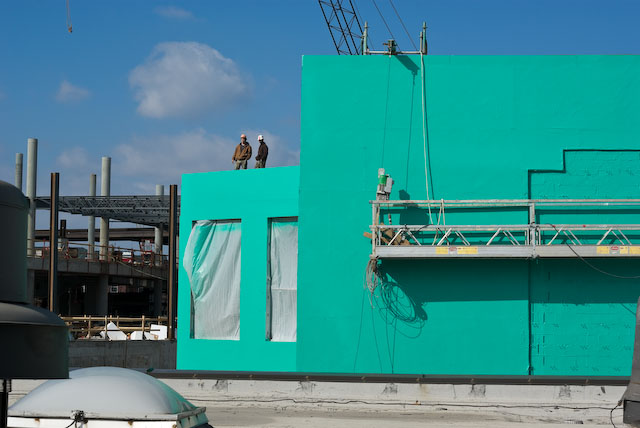Posts tagged Pentax K10D
(f)light reading
Pentax K10D, Pentax-A SMC 50mm f/1.7 (manual focus), ISO 640 (auto), f/1.7, 1/100 sec, +/-0 EV, IS: ON (converted to b/w and toned in Adobe Lightroom)
Snapped on my way back from Milwaukee Friday. I’m going to start posting more of my Flickr photos here in an effort to make it easier for those of you who follow my blog to follow my pictures as well. I’m planning on posting the large version of my photos but would appreciate feedback on that decision. Please feel free to post any questions about my photos in the comments here or on Flickr (photo links back to Flickr page).
Pentax SMCP-DA* 16-50mm f/2.8 ED AL (IF) SDM user review
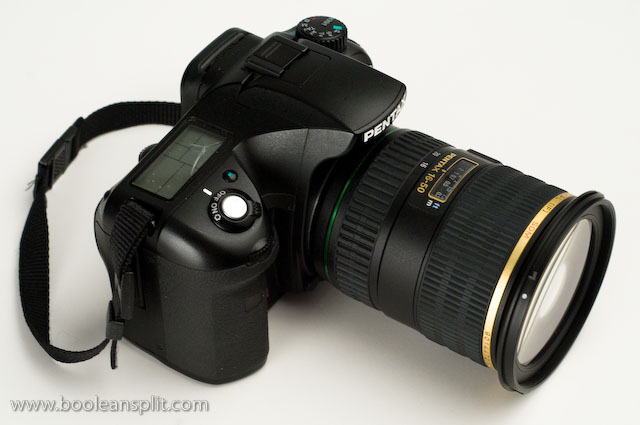
My friend Stephen loaned me his Pentax SMCP-DA* 16-50mm f/2.8 ED AL (IF) SDM lens so I could put it through its paces and compare it to my kit lens (SMCP-DA 18-55mm f/3.5-5.6 AL). If you don’t know already, Pentax’s DA* (”D-A-star”) line of lenses are their highest quality zooms. They feature very high quality construction, weather sealing, silent ultrasonic focus motors (SDM), and Pentax’s best SMC coatings (SP) to date. Retailing at close to $700 this lens seems like it should be a huge step up from the $99 kit lens.
This isn’t a technical review. If you want MTF and distortion charts go here. Instead, I’m just going to cover my observations during real world everyday use. Keep in mind that I do have a unique perspective here so take my opinions with an appropriate grain of salt. Here are my overall findings. Feel free to read on for a more in-depth look at how I formulated my opinions.
PROS:
- Excellent build quality
- Useful zoom range
- Silent SDM focus motor
- Weather seals
- 9 bladed aperture
CONS:
- Very soft around the edges wide open
- Distracting CAs below f/4
- Big and heavy
- Very long for a 50mm lens
- Pronounced barrel distortion at 16mm
- Expensive
CONCLUSION:
While I would normally suggest upgrading the standard kit lenses from Canikon, Pentax has done an excellent job with their SMCP-DA 18-55mm f/3.5-5.6 AL and this gussied up DA* lens only helps to prove that point. Had I bought this lens myself I would have sent it back after the first day and put my money to better use. This is a big, heavy and expensive lens that does not prove a significant upgrade to the kit lens in everyday use. Get and/or keep the kit lens and put your money towards a dedicated ultra-wide angle lens and/or some fast primes to compliment the kit lens (some suggestions can be found at the end of this article).
REVIEW:
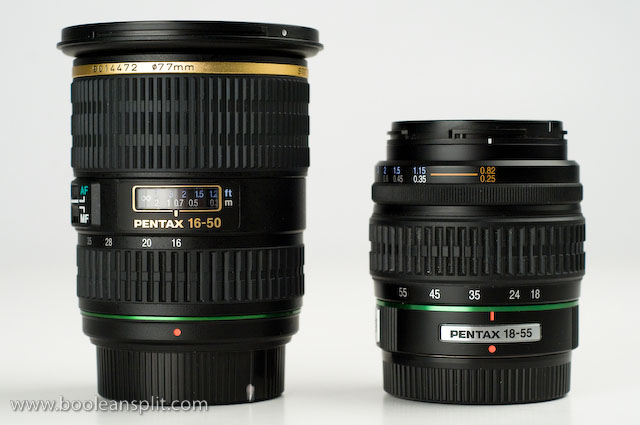
Purchasing a lens for me encompasses four primary areas of concern: image quality, build quality, handling, and value. There is no standard order of importance here as all of these issues carry different weight depending on the intended application of the lens in question. In this case, the 16-50 seems ideally positioned as an upgrade to the standard kit lens. This makes it an all purpose lens that should perform equally well in all four areas while handily outperforming the kit lens (which is why I am comparing the two here).
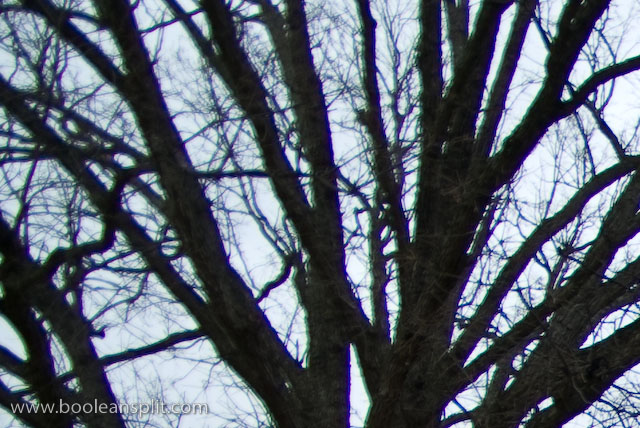
Image Quality
I think the crop above says it all. Shoot this lens at 16mm with anything less than f/4 and the color fringing (chromatic aberrations or “CAs”) and edge softness are quite disappointing. F/8 is required to eliminate the problem altogether from wide shots. The fringing persists all the way up to 50mm but is generally less of a problem at the longer focal lengths due to the shorter depth of field at f/2.8 (CAs get lost in the bokeh). Center sharpness is pretty good wide open (f/2.8) at all focal lengths and becomes tack sharp at f/4 and above. Overall color and contrast are very good (as it is with all Pentax lenses).
My biggest issue here is that the three main advantages this lens should have over the kit lens are sharpness, speed and the wider field of view (FoV). I found myself stopping down to at least f/4 for most of my shots with this lens, only using f/2.8 in extremely low light hand-held situations and when controlling the depth of field (DoF) was critical. The extra 2mm on the wide end (16mm vs. 18mm in the kit lens) are noticeable due to the greater FoV but more notably for the exaggerated barrel distortion. This isn’t a deal breaker for me but is disappointing at this price point.
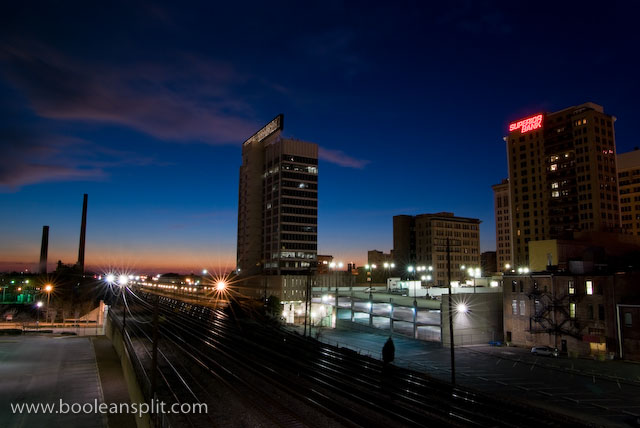
On the other hand, stopped all the way down to f/22 and opened up wide to 16mm, this lens produces some very nice results for landscape photography. Its nine bladed aperture creates awesome 18 pointed starbursts with very little flare. This is one of the areas where the higher build quality of the DA* really shines (pun intended).
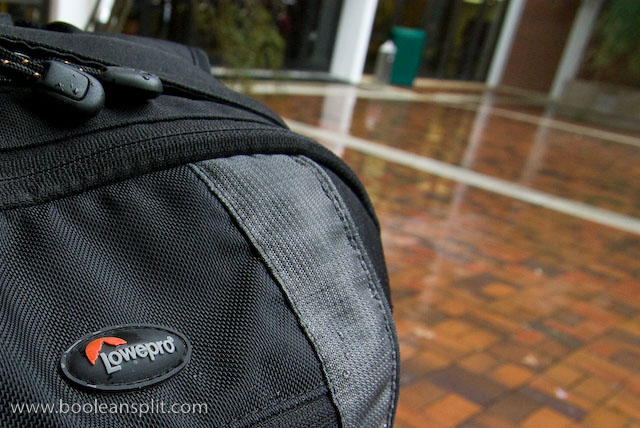
That 9 bladed aperture also produces very nice bokeh even when stopped down. The image above was taken at 16mm and f/8 and exhibits very smooth blurring of the background with mostly circular out of focus highlights. This shot also illustrates the 16-50’s macro performance. It’s 0.3m (11.8″) minimum focus distance makes it pretty useful for getting in tight even if the 50mm maximum focal length doesn’t provide a tremendous amount of magnification. Keep in mind that the minimum focus distance of a lens is measured from the sensor (ie: film) plane in the camera body and not from the front of the lens. This means that at 50mm you can get up to about 3-4″ away from the subject with the front glass. This may be useful sometimes and a problem at others. Personally, I like shots like this where you get in close with the wide angle to exaggerate scale and perspective. Meanwhile, the kit lens can focus down to 0.25M (9.8″)…
Build Quality
Not much to say here. This lens is built as well or better than the best lenses from any mainstream manufacturer. One heft and you will not question its price tag. Typical to the DA* line, the 16-50 features gasketed seals to prevent dust and moisture penetration, including a seal at the lens mount to seal it to the camera body. Combined with Pentax’s weather sealing on the K10/20D bodies this makes for a very practical all-weather combination. I’m sure this is a useful upgrade but I have shot in some pretty nasty conditions with my kit lens and have not had any problems with moisture penetration. (I have to wonder if most non-professional photographers would put their cameras through the kind of abuse this level of construction suggets is possible). The zoom and focus rings are well damped and buttery smooth with nicely ribbed rubber rings. There is no slop or wiggle between the various moving parts anywhere throughout the zoom range.
Handling
For me this is one of the most conflicting areas for this lens. On one hand Pentax has included some very nice design features that make this lens a worthy step up from the kit lens. On the other hand, the sheer bulk of this lens really gets in the way. Here are a couple of the nicer design features:
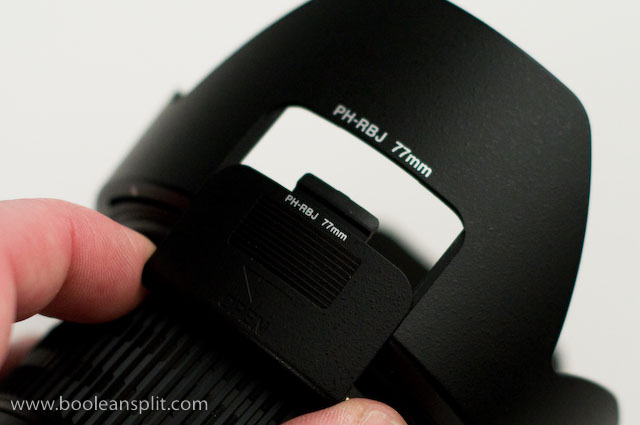
The access port on the lens hood is a nice touch common to all Pentax lenses. It allows access to the control ring on rotating filters without removing the lens hood (like polarized, graduated and special effects filters). This is a very user-friendly feature that all lens makers should adopt. After all, you usually find yourself needing to use these types of filters and the lens hood at the same time anyway, right?
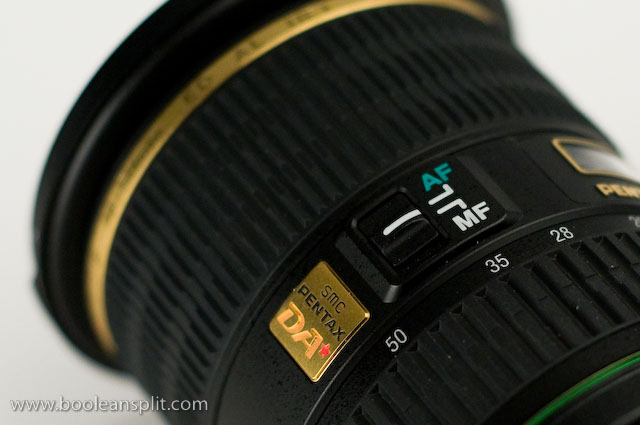
Another nice feature of this lens is the SDM ultrasonic focus system. This lens focuses absolutely silently. This can be a bit strange at first considering how loud the screw drive focus system is with standard lenses. It’s not noticeably faster or more accurate than the screw drive system (still hunts too much IMO) but its silent operation draws less attention to the fact that you are taking pictures (if only the extra-loud shutter wouldn’t betray us so). The focus ring can be used anytime to fine tune the focus. However, it is not directly coupled to the focus mechanism so it does not stop turning when you reach the either end of the focus range. Pentax has included an AF/MF selector switch on the lens for those times when you want full time manual control. This is a lot easier to use than the switch on the camera body and is a nice touch.
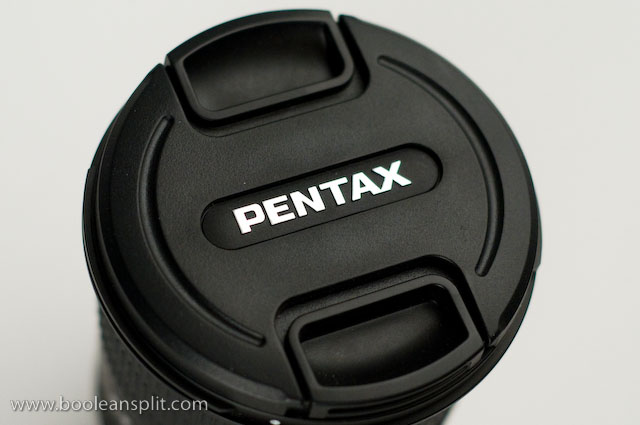
Why does Pentax make me spend $700 to get a decent center pinch lens cap?
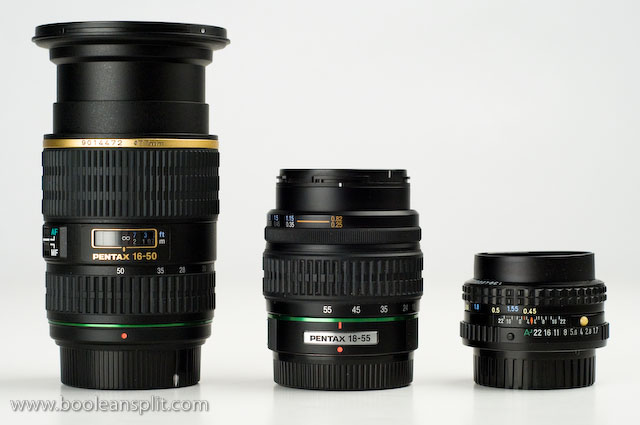
Now for the bad news. This lens is a brick. On my kitchen scale the 16-50 weighs 20oz while the 18-55 kit lens weighs in at 8oz and my old 50mm f/1.7 is only 5 3/4oz. (BTW, the K10D body w/ battery weighs 28oz). I realize that there is a weight penalty to step up to f/2.8 in a zoom but, considering this lens’ lackluster performance at f/2.8, I really have to question the benefit here. I mean, why carry around all this glass if you’re going to be shooting at f/4 anyway?
Mounting this lens to the front of my K10D felt very awkward. The grip on the K10D is a bit shallow and hanging all that weight off the front of the camera made it very difficult to hold securely with one hand. I found myself carrying the camera by the lens and having to use two hands for most of my shots. (Adding a battery grip would help balance the camera and provide better leverage with the heel of your right hand). Don’t get me wrong. I don’t mind a heavy and expensive lens if the performance and application justifies it. (Canon’s EF 70-200mm f/2.8L IS USM is one of my all time favorites). Overall this did not prove to be a very good walking around combination. I find this interesting since this sort of everyday use seems to be the main focus of lenses in this zoom range.
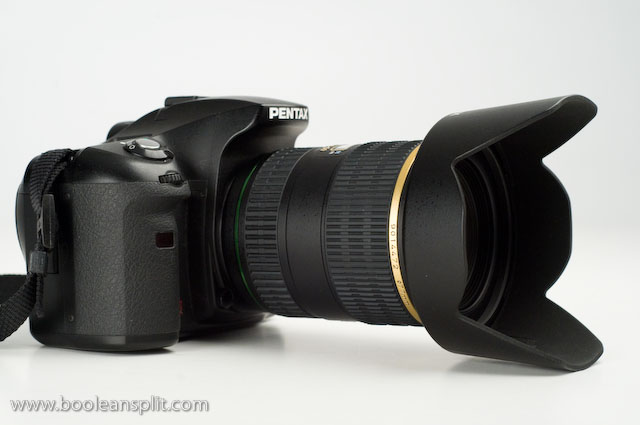
Another negative aspect the comparison photo in the section above illustrates is how long this lens is. The 16-50 is at its longest (5 3/8″ to the mount) at 50mm and its shortest (4″) at 16mm (as shown directly above with lens hood). The kit lens is only 3 1/8″ at its longest which is at 55mm and 18mm. As you zoom from 18mm to 55mm the kit lens starts off long then retracts to its shortest length of 2 3/4″ at 35mm then back out to 3 1/8″ at 55mm. This double action means it only has to extend half as much (percentage wise) as the 16-50 does throughout its zoom range. I point this out mainly because 50mm on a 1.5X APS-C sensor is the equivalent of 75mm on a full frame sensor and 35mm film. This puts it right in the sweet spot for close portrait photography. However, when you point this thing at people they tend to back away as if you’ve just aimed a bazooka at them. I imagine it would be fine in studio situations but for candids and street photography the kit lens (or better yet, a 50mm prime) is clearly the better choice.
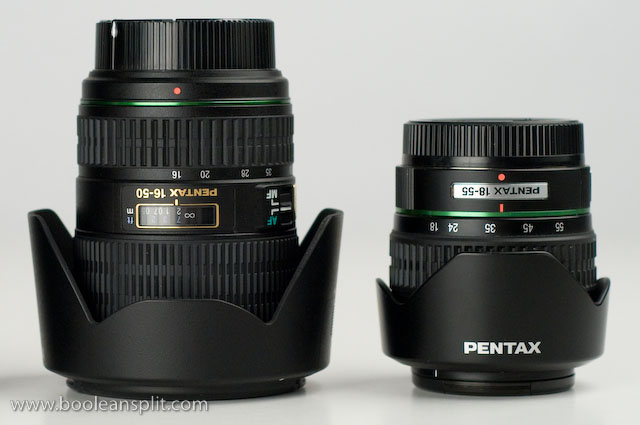
Not to belabor the point too much here, but another aspect that should be considered with respect to lens size is how much space it takes up in your bag. Here you can see the 16-50 f/2.8 DA* and kit lens both suited up for travel with hoods and caps. As you can see, the 16-50 will require a pretty massive hole in your bag (4 1/8″ X 4 7/8″). If you are anything like me you have to consider very carefully what goes in your camera bag. Which brings me to my conclusion…
The advertised advantages of this lens are its wide FoV (16mm), speed (f/2.8), SDM focus motor, build quality, 9 bladed aperture, weather sealing, and sharpness. However, in actual use I don’t find any of these things in combination to be a significant enough improvement over than the kit lens as to justify the price and bulk of the 16-50 f/2.8 DA*. In fact, if this were the kit lens I would be looking to upgrade. If you have $700 burning a hole in your pocket there are a number of better choices out there.
I suggest you look at the Pentax SMCP-DA 12-24mm f/4 ED AL (IF) ($670). It is a re-badge of the stellar Tokina 12-24mm f/4 AT-X 124AF Pro DX ($490) and makes a much more useful ultra-wide angle addition to the kit lens. (It is a bit frustrating that we Pentax users have to pay an extra $200 for the same lens the Canikon folks can get directly from Tokina). It is still pretty heavy (15oz) and will take up just as much room in your bag as the 16-50, but the ultra-wide angle shots you’ll get with this lens will absolutely blow you away. If speed and sharpness are what you are looking for pick up a fast prime or two like the Pentax SMCP-FA 50mm f/1.4 ($200) and/or the Pentax SMCP-DA 35mm f/2.8 Macro Limited ($480). If you really feel a burning need to try out a DA* lens, check out the new Pentax SMCP-DA* 200mm f/2.8 ED (IF) SDM ($890). Its bulk is easily justified by its extra reach and speed (just beware of some nasty purple fringing in high contrast scenes).
Finally, if you are buying a new Pentax body and are looking for an upgraded alternative to the kit lens, don’t. The kit lens is one of the best values available for these cameras. If you are determined, take a look at Sigma’s 18-50mm f/2.8 EX DC Macro ($420). This was the lens I originally bought with my first K10D back in ‘07. It is not nearly as big and heavy as the Pentax 16-50 f/2.8, has almost identical image quality, and adds a very useful macro focus capability across the entire zoom range. I shot several thousand shots with it in 2007 in several parts of the world and can attest to its quality. That being said, I now know that the Pentax 18-55mm kit lens makes better pictures ;-)
Some sample photos taken with this lens during testing.
UPDATE:
A number of readers have suggested that Pentax’s $380 SMCP-DA 16-45mm f/4.0 ED AL might be a better upgrade choice over the 16-50mm f/2.8 DA*. I have no experience with this lens so I did not mention it as an alternative. Reading over the photozone.de test report I can see that at only 12.9oz it is considerably lighter than the 16-50 DA*. Size wise it is slightly smaller than the 16-50 DA* with the added benefit of being at its shortest at 45mm (opposite of the 16-50). Also, it features an 8 bladed diaphragm which should result in decent bokeh and nice starbursts when stopped down. Resolution seems to be very good with distortion and vignetting similar to the 16-50 DA*. The only real noteworthy negative mentioned is heavy CAs at the edges of wide angle shots. If I can get my hands on one of these I will definitely post a similar review and find out if this lens is worthy of consideration.
After writing this review it was brought to my attention that the 16-50mm f/2.8 DA* has suffered from some quality control issues. It is entirely possible that this example is flawed. However, in researching this a bit more I still find a number of reviews pointing to similar image quality problems on lenses that are supposedly in proper working order. Potential QC problems aside, my opinion remains unchanged about this lens.
Blue Hour made simple
I’ve already blogged here once about taking sunset photos but after taking this blue hour shot tonight I just had to share how easy this is.
I had to run downtown around 6pm to pick up some fresh oysters from the Fish Market. On the way out the door I grabbed my Pentax K10D, 16-50 f/2.8 DA* (borrowed) and tripod. I made a bee line down 21st Street South (past the Fish Market) to the viaduct that goes over the railroad tracks into downtown. From this elevated vantage point over the tracks I knew I would have a decent view west with enough streetlights for some killer starburst action.
Here’s the set-up for this shot:
- camera mode: MANUAL (you can’t do this in AUTO!)
- aperture: f/22
- shutter speed: 30 seconds
- ISO: 100*
- white balance: AUTO
- flash: OFF (!!)
- IS: OFF
- auto focus: OFF (manually set focus to ∞)
- self timer: ON (2 second delay)
- focal length: widest setting (here: 16mm)
- battery: fully charged (!)
*Nikon users with ISO 200 as the lowest setting may have to back off the shutter to 15-20 seconds.
That’s it. Mount the camera on a tripod, compose the shot, trip the shutter (using the self timer prevents camera shake), step back, and wait. If you time the light right that’s all you’ll ever have to do. The small aperture ensures everything is in focus and creates dazzling starbursts. The long exposure pulls in all kinds of light and colors and the low ISO keeps things s-m-o-o-t-h. I did shoot this photo in RAW but all I did in Lightroom to this shot is apply my standard import settings and touch up a little sensor dust.
Truthfully, I rarely look at the exposure meeter for these shots. I usually just take a 30 second f/22 shot at ISO 100 and check the LCD. If it’s too dark I’ve probably missed the magic blue hour and it’s either time to pack it up or break out the DIY bulb switch (though I usually try a few in vain at f/16 and f/8 just to be sure). If the shot is too bright I’ll just back off the shutter to 15 seconds and try again. If that doesn’t work I just wait a bit until the light drops off some more. The only real hard part is getting the timing right (most people are packing up to leave about the time I’m setting up for my best shots) and being patient (30 second exposures can seem like an eternity sometimes).
It’s really one of the few never-fail shots if you use these settings. Trick is you pretty much have to use all of these settings to get decent results. Break out the tripod and give it a try tomorrow night!
Here are a few more examples on my Flickr stream if you’re interested.
Why do I shoot RAW?
Here’s a recent quote from Ken Rockwell’s blog:
The Canon 5D Mark II’s in-camera JPG processing is awful if you’re making huge prints. The in-camera processing of the raw data oversharpens harsh edges, adds too much contrast and smudges subtle textures into mush.
For the Canon 5D Mark II, if you’re making huge enlargements, shooting CR2 files and processing them with Adobe Lightroom 2.2 makes a world of improvement over in-camera processing. Shooting CR2 files in the 5D Mark II and processing them in Lightroom 2.2 makes files almost indistinguishable from the JPGs that come directly out of the Nikon D3X.
I find this quite amusing as Ken is infamous for bashing anyone who shoots RAW as a hack. Read his article on RAW vs. JPEG to see what I mean. If you can get beyond all of his opinions there is some pretty useful information in there.
Personally, I pretty much agreed with Ken and shot JPEG exclusively up until last year. I switched to shooting RAW with my Pentax K10D and post processing with Adobe Lightroom when I discovered how much better the RAW images looked coming out of Lightroom as JPEGs than they ever did coming out of the camera. The thing that makes it work for me is that I know the camera so well that I can picture what post processing adjustments I am going to need to do to an image as I’m peering through the viewfinder… much the same way a good film photographer considers how they will later develop and print an image in the darkroom.
I have lens specific import presets for my K10D’s RAW files that automatically apply my preferred adjustments during import (Sharpening, Detail, Clarity, Vibrance, Noise Reduction, Defringing, etc.). I shoot in auto white balance mode so all the post processing I have to do is make any required adjustments to the WB where the camera missed (which happens more often than not. Often, I can do this quite simply with a large number of images shot in the same light with less than 3 clicks (click on the first image, shift-click on the last, click on the WB pull-down tab, scroll to the correct WB preset and release). I certainly fail to see how this can be any more time consuming than fiddling with the in-camera WB settings while shooting.
I don’t recommend shooting RAW for beginners. Post processing can be a quagmire where inexperienced photographers often get lost and discouraged. However, once you get to the point that you can see what kinds of adjustments an image might need before you even release the shutter, shooting RAW starts to make a lot of sense. Used wisely, RAW images can open up a whole new world of creative and critical control. Best of all, you can always reset the image back to the default as-shot capture and do it all over again- all without creating multiple JPEG files to keep track of and store.
If you want to get an idea of what shooting RAW will do for your core image quality, look up the review of your camera on dpreview.com and navigate to the “Compared to (JPEG)” and “Compared to (RAW)” sections.
Camera Dojo just posted a pretty in-depth article on the same subject that is worth taking a look at.
About
Subscribe
Recent Posts
- Blog moving
- line of defense
- studio shoot
- handle bar
- Happy Easter!
- dance floor quietly waiting
- work in progress
- warmth
- Pentax SMCP-DA 35mm f/2.8 Macro Limited User Review
- garage’d
Categories
Pages
Flickr Friends
- .ƒenster.
- another planet
- ANVRecife
- Bradley Spitzer
- catklein
- Chris Blanz
- crashmattb
- derrickstembridge
- iamchanelle
- iandoubleyou
- Mulsanne
- raisinsawdust
- Sean Mantey
- stephen_woolverton
- Takayuki Imai
- viajvia
- [Christine]
Links
- Adorama
- Amazon
- B&H Photo
- bradleyspitzer.com
- Camera Dojo
- Cameta Camera
- dpreview
- engadget
- iandoubleyou.com
- KenRockwell
- Shutter Sisters
- The Luminous Landscape
- The Online Photograher
- TUAW
- Wolf Camera

